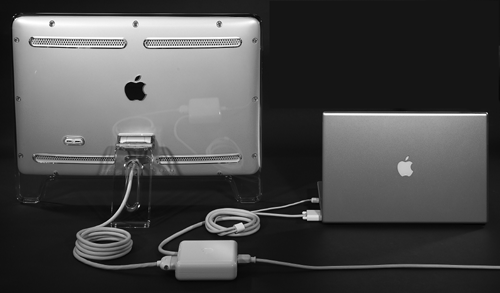Apple LCDs
Apple incorporates LCD technology in its PowerBook and iBook portable computers, in its flat-panel iMac and iMac G5 desktop systems, and in its standalone line of Apple Cinema Displays. In fact, in May 2001, Apple was the first computer manufacturer to switch its entire display product line to LCD models. The current line of Apple Cinema Displays feature very thin bezels and aluminum enclosures, with viewable image sizes of 30, 23, and 20 inches diagonally.

All of the Apple standalone display products are thin film transistor (TFT) active-matrix LCDs, and all use a digital graphics signal. All current Apple Cinema Display models connect to the Digital Visual Interface (DVI) commonly found on Power Macs, PowerBooks, and Windows-based computers. Earlier Apple Studio Display models connected to Macintoshes with the Apple Display Connector (ADC), a single-connection quick-latch mechanism that combines USB, power, and video in one cable, for easy hookup and reduced desktop clutter.
MORE INFO
For a complete list of user's manuals for these displays, refer to Knowledge Base document 50125, “Cinema Display Manuals.” If you are a member of the Apple extended audience, you can also refer to 50153, “Display Service Manuals.”
The Apple LCD Models
| Apple Cinema HD Display (23-inch) | Apple Cinema Display (20-inch) | Apple Cinema HD Display (20-inch DVI) | Apple Cinema HD Display (23-inch DVI) | Apple Cinema HD Display (30-inch DVI) | |
|---|---|---|---|---|---|
| Introduced | March 2002 | January 2003 | June 2004 | June 2004 | June 2004 |
| Model | M8537ZM/A | M8893ZM/A | M9177LL/A | M9178LL/A | M9179LL/A |
| Technical specifications | Knowledge Base document 88358 | Knowledge Base document 86214 | N/A[*] | N/A[*] | N/A[*] |
| Screen size (diagonal) | 23 inches | 20 inches | 20 inches | 23 inches | 30 inches |
| Screen type | TFT active-matrix LCD | TFT active-matrix LCD | TFT active-matrix LCD | TFT active-matrix LCD | TFT active-matrix LCD |
| Display colors (maximum) | 16.7 million | 16.7 million | 16.7 million | 16.7 million | 16.7 million |
| Typical viewing angle | 160° horizontal 160° vertical | 160° horizontal 160° vertical | 170° horizontal 170° vertical | 170° horizontal 170° vertical | 170° horizontal 170° vertical |
| Typical brightness (cd/m2) | 200 | 230 | 250 | 270 | 270 |
| Typical contrast ratio | 350:1 | 350:1 | 400:1 | 400:1 | 400:1 |
| Supported resolutions | 1920x1200 (default) 1280x800 1024x600 800x500 | 1680x1050 (default) 1280x800 1024x640 | 1680x1050 (default) 1280x800 1024x640 | 1920x1200 (default) 1280x800 1024x600 | 2560x1600 (default) 2048x1280 1920x1200 1280x800 1024x600 |
[*] The technical specifications for this product are currently available at www.apple.com/displays/specs.html. Be aware that as Apple introduces newdisplays, the information on this web page may refer to different models. Inthat case, search the Knowledge Base for “klcd specifications” to locate documents pertaining to legacy products.
It seems obvious, but bears repeating: LCDs are fragile. These units are designed to minimize weight, so the glass is thin and therefore easy to break. Clean the surface very gently when necessary, following the guidelines in Lesson 4, “Safe Working Procedures and General Maintenance,” and be sure not to apply any heavy pressure to the glass.
Apple DVI to ADC Adapter
Using the Apple DVI to ADC Adapter (M8661LL/A), customers can connect their Macintosh computer's DVI to a flat-panel display that has an ADC, such as an Apple Studio Display.

MORE INFO
To learn the compatibility of a specific graphics card–display combination, refer to Knowledge Base document 75286, “Apple DVI to ADC Adapter: Compatibility Table.”
DVI and ADC connectors both transmit digital signals, but their pin configurations are quite different. The Apple DVI to ADC Adapter simply maps the pins in the computer's DVI port to the appropriate pins on the monitor's ADC port. Similarly, there are third-party solutions that can also convert the ADC's digital video signals into analog signals used on VGA ports, but this conversion degrades the picture quality.
In addition to digital video, displays with an ADC connector receive USB signals and power from their ADC connection. The Apple DVI to ADC Adapter routes both through the display's ADC cable from the computer's USB port and power outlet.
To connect the Apple DVI to ADC Adapter, follow these steps:
1. | Attach the adapter's DVI connector to the DVI port on the computer. |
2. | Attach the adapter's USB connector to a USB port on the computer. |
3. | Attach the display cable's ADC connector to the ADC port on the adapter. |
4. | Insert the adapter's small power plug into the adapter's power port. |
5. | Insert the adapter's other power plug into a power outlet. |
6. | Turn on the computer. |
